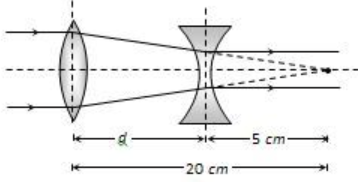A convex lens A of focal length 20 cm and a concave lens B of focal length 5 cm are kept along the same axis with the distance d between them. If a parallel beam of light falling on A leaves B as a parallel beam, then distance d in cm will be (a). 25 (b). 15 (c). 30 (d). 50
By BYJU'S Exam Prep
Updated on: September 13th, 2023
We know that
A convex Lens is a lens thick at the center but thinner at the edges (both the surfaces are curved outwards).
A concave lens is a lens thin in the middle but thicker at the edges (both the surfaces are curved inwards).
In the absence of a concave lens, the parallel beam will be focused at F2 of the convex lens, i.e., at a 20 cm distance.
5 cm is the focal length of a concave lens, i.e., if the lens is placed at 5 cm from F2 towards the left, the beam will become parallel.
In the figure, the separation between the lenses is clear
d = 20 – 5 = 15 cm

Therefore, the distance d in cm will be 15.
Summary:
A convex lens A of focal length 20 cm and a concave lens B of focal length 5 cm are kept along the same axis with the distance d between them. If a parallel beam of light falling on A leaves B as a parallel beam, then distance d in cm will be (a). 25 (b). 15 (c). 30 (d). 50
A convex lens A of focal length 20 cm and a concave lens B of focal length 5 cm are kept along the same axis with the distance d between them. If a parallel beam of light falling on A leaves B as a parallel beam, then distance d in cm will be 15.
Related Questions:-
- A Circuit When Connected To An Ac Source Of 12 Volt Gives The Current Of 0 Point 2 Ampere Same Circuit When Connected To The Dc Source Of 12 Volt Gives A Current Of 0 Point 4 A?
- If The Magnitude Of The Resultant Of Two Vectors Of Equal Magnitudes Is Equal To The Magnitude Of Either Vectors?
- Explain The Process Of Digestion Of Food In Mouth Stomach And Small Intestine In Human Body?


